Transitional Nursing Practice
VerifiedAdded on 2023/05/28
|10
|2409
|470
AI Summary
This article discusses the transition phase from nursing student to graduate nurse and the importance of evidence-based nursing practice. It includes case studies on managing patients with diabetes and cystic fibrosis, and emphasizes the need for proper documentation, communication, and core nursing values.
Contribute Materials
Your contribution can guide someone’s learning journey. Share your
documents today.
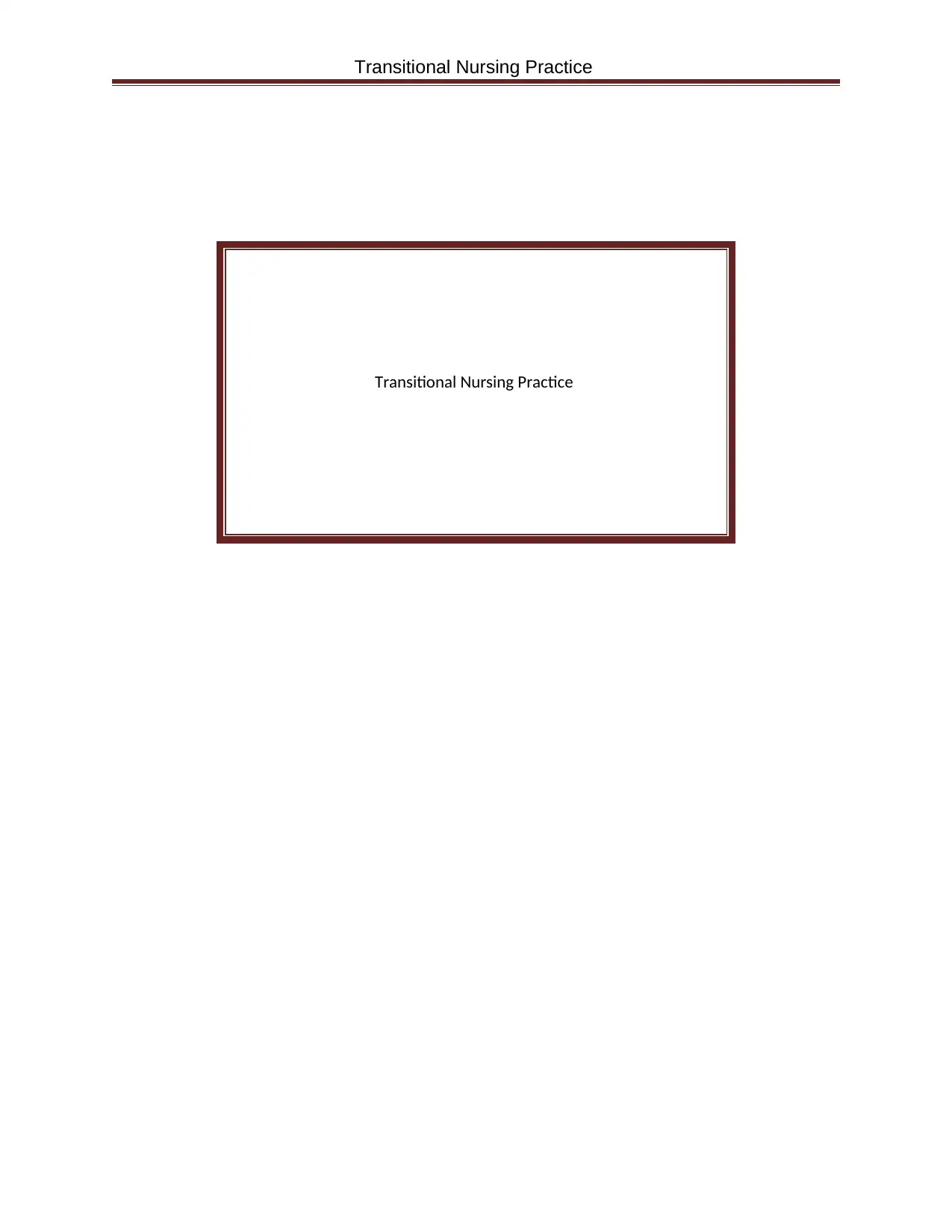
Transitional Nursing Practice
Transitional Nursing Practice
Transitional Nursing Practice
Secure Best Marks with AI Grader
Need help grading? Try our AI Grader for instant feedback on your assignments.
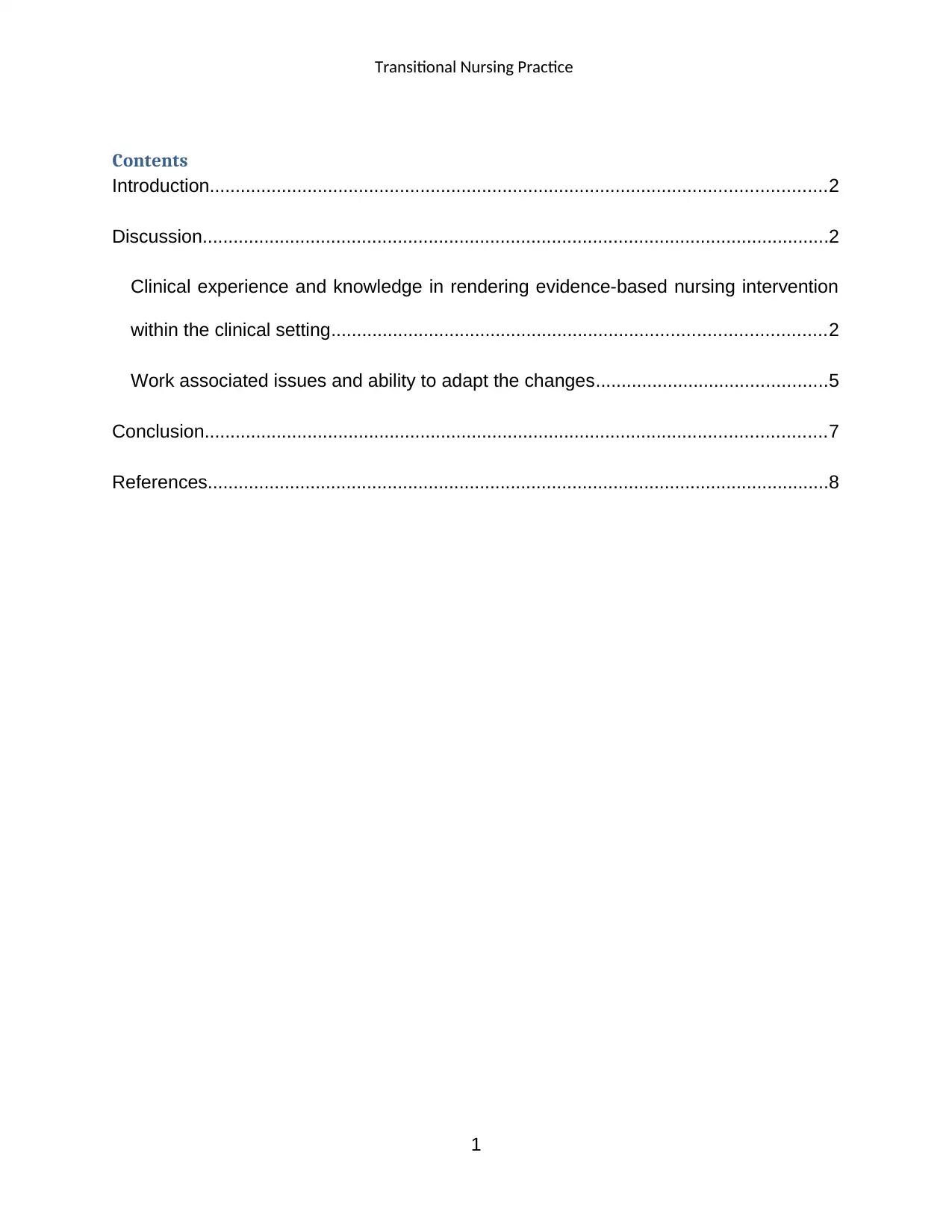
Transitional Nursing Practice
Contents
Introduction........................................................................................................................2
Discussion..........................................................................................................................2
Clinical experience and knowledge in rendering evidence-based nursing intervention
within the clinical setting................................................................................................2
Work associated issues and ability to adapt the changes.............................................5
Conclusion.........................................................................................................................7
References.........................................................................................................................8
1
Contents
Introduction........................................................................................................................2
Discussion..........................................................................................................................2
Clinical experience and knowledge in rendering evidence-based nursing intervention
within the clinical setting................................................................................................2
Work associated issues and ability to adapt the changes.............................................5
Conclusion.........................................................................................................................7
References.........................................................................................................................8
1
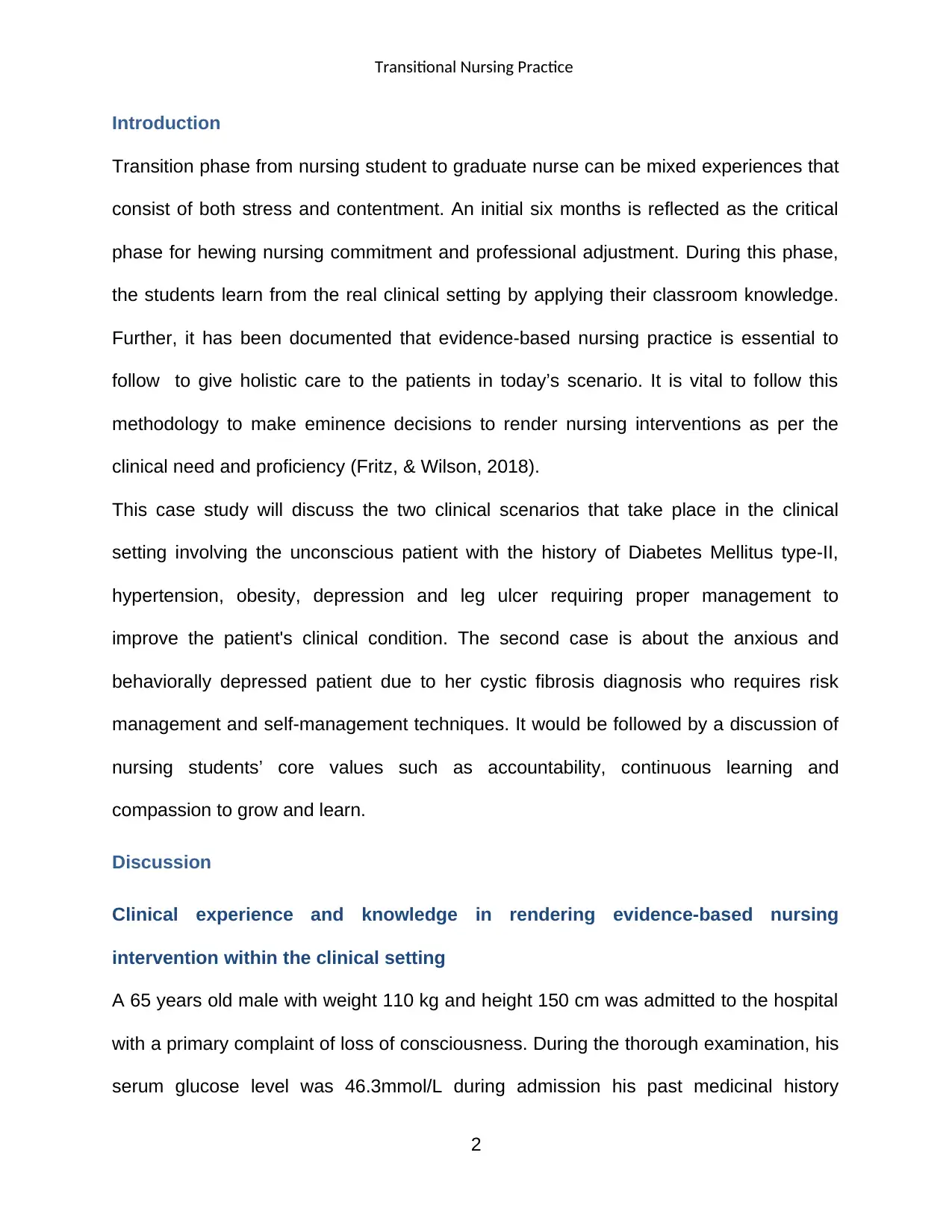
Transitional Nursing Practice
Introduction
Transition phase from nursing student to graduate nurse can be mixed experiences that
consist of both stress and contentment. An initial six months is reflected as the critical
phase for hewing nursing commitment and professional adjustment. During this phase,
the students learn from the real clinical setting by applying their classroom knowledge.
Further, it has been documented that evidence-based nursing practice is essential to
follow to give holistic care to the patients in today’s scenario. It is vital to follow this
methodology to make eminence decisions to render nursing interventions as per the
clinical need and proficiency (Fritz, & Wilson, 2018).
This case study will discuss the two clinical scenarios that take place in the clinical
setting involving the unconscious patient with the history of Diabetes Mellitus type-II,
hypertension, obesity, depression and leg ulcer requiring proper management to
improve the patient's clinical condition. The second case is about the anxious and
behaviorally depressed patient due to her cystic fibrosis diagnosis who requires risk
management and self-management techniques. It would be followed by a discussion of
nursing students’ core values such as accountability, continuous learning and
compassion to grow and learn.
Discussion
Clinical experience and knowledge in rendering evidence-based nursing
intervention within the clinical setting
A 65 years old male with weight 110 kg and height 150 cm was admitted to the hospital
with a primary complaint of loss of consciousness. During the thorough examination, his
serum glucose level was 46.3mmol/L during admission his past medicinal history
2
Introduction
Transition phase from nursing student to graduate nurse can be mixed experiences that
consist of both stress and contentment. An initial six months is reflected as the critical
phase for hewing nursing commitment and professional adjustment. During this phase,
the students learn from the real clinical setting by applying their classroom knowledge.
Further, it has been documented that evidence-based nursing practice is essential to
follow to give holistic care to the patients in today’s scenario. It is vital to follow this
methodology to make eminence decisions to render nursing interventions as per the
clinical need and proficiency (Fritz, & Wilson, 2018).
This case study will discuss the two clinical scenarios that take place in the clinical
setting involving the unconscious patient with the history of Diabetes Mellitus type-II,
hypertension, obesity, depression and leg ulcer requiring proper management to
improve the patient's clinical condition. The second case is about the anxious and
behaviorally depressed patient due to her cystic fibrosis diagnosis who requires risk
management and self-management techniques. It would be followed by a discussion of
nursing students’ core values such as accountability, continuous learning and
compassion to grow and learn.
Discussion
Clinical experience and knowledge in rendering evidence-based nursing
intervention within the clinical setting
A 65 years old male with weight 110 kg and height 150 cm was admitted to the hospital
with a primary complaint of loss of consciousness. During the thorough examination, his
serum glucose level was 46.3mmol/L during admission his past medicinal history
2
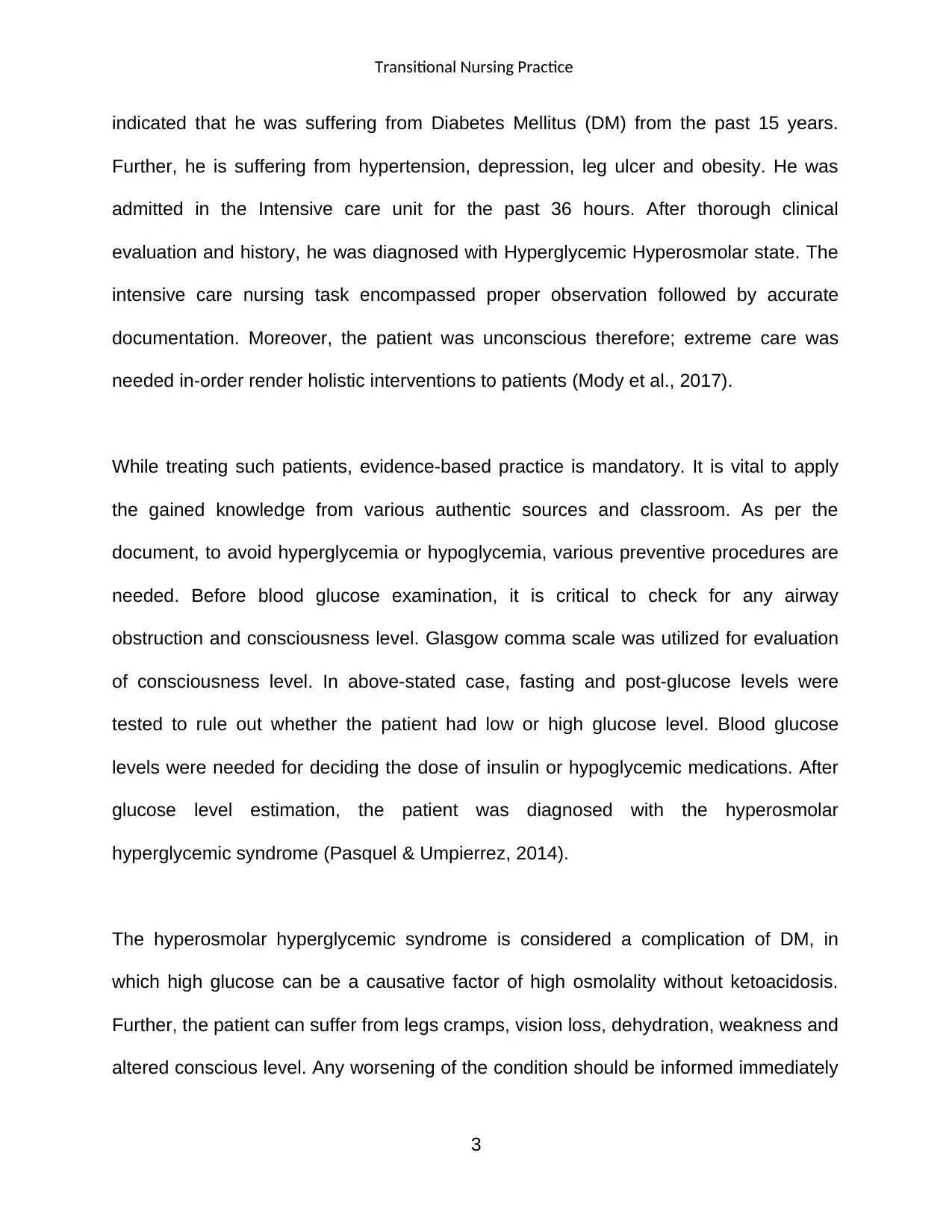
Transitional Nursing Practice
indicated that he was suffering from Diabetes Mellitus (DM) from the past 15 years.
Further, he is suffering from hypertension, depression, leg ulcer and obesity. He was
admitted in the Intensive care unit for the past 36 hours. After thorough clinical
evaluation and history, he was diagnosed with Hyperglycemic Hyperosmolar state. The
intensive care nursing task encompassed proper observation followed by accurate
documentation. Moreover, the patient was unconscious therefore; extreme care was
needed in-order render holistic interventions to patients (Mody et al., 2017).
While treating such patients, evidence-based practice is mandatory. It is vital to apply
the gained knowledge from various authentic sources and classroom. As per the
document, to avoid hyperglycemia or hypoglycemia, various preventive procedures are
needed. Before blood glucose examination, it is critical to check for any airway
obstruction and consciousness level. Glasgow comma scale was utilized for evaluation
of consciousness level. In above-stated case, fasting and post-glucose levels were
tested to rule out whether the patient had low or high glucose level. Blood glucose
levels were needed for deciding the dose of insulin or hypoglycemic medications. After
glucose level estimation, the patient was diagnosed with the hyperosmolar
hyperglycemic syndrome (Pasquel & Umpierrez, 2014).
The hyperosmolar hyperglycemic syndrome is considered a complication of DM, in
which high glucose can be a causative factor of high osmolality without ketoacidosis.
Further, the patient can suffer from legs cramps, vision loss, dehydration, weakness and
altered conscious level. Any worsening of the condition should be informed immediately
3
indicated that he was suffering from Diabetes Mellitus (DM) from the past 15 years.
Further, he is suffering from hypertension, depression, leg ulcer and obesity. He was
admitted in the Intensive care unit for the past 36 hours. After thorough clinical
evaluation and history, he was diagnosed with Hyperglycemic Hyperosmolar state. The
intensive care nursing task encompassed proper observation followed by accurate
documentation. Moreover, the patient was unconscious therefore; extreme care was
needed in-order render holistic interventions to patients (Mody et al., 2017).
While treating such patients, evidence-based practice is mandatory. It is vital to apply
the gained knowledge from various authentic sources and classroom. As per the
document, to avoid hyperglycemia or hypoglycemia, various preventive procedures are
needed. Before blood glucose examination, it is critical to check for any airway
obstruction and consciousness level. Glasgow comma scale was utilized for evaluation
of consciousness level. In above-stated case, fasting and post-glucose levels were
tested to rule out whether the patient had low or high glucose level. Blood glucose
levels were needed for deciding the dose of insulin or hypoglycemic medications. After
glucose level estimation, the patient was diagnosed with the hyperosmolar
hyperglycemic syndrome (Pasquel & Umpierrez, 2014).
The hyperosmolar hyperglycemic syndrome is considered a complication of DM, in
which high glucose can be a causative factor of high osmolality without ketoacidosis.
Further, the patient can suffer from legs cramps, vision loss, dehydration, weakness and
altered conscious level. Any worsening of the condition should be informed immediately
3
Secure Best Marks with AI Grader
Need help grading? Try our AI Grader for instant feedback on your assignments.
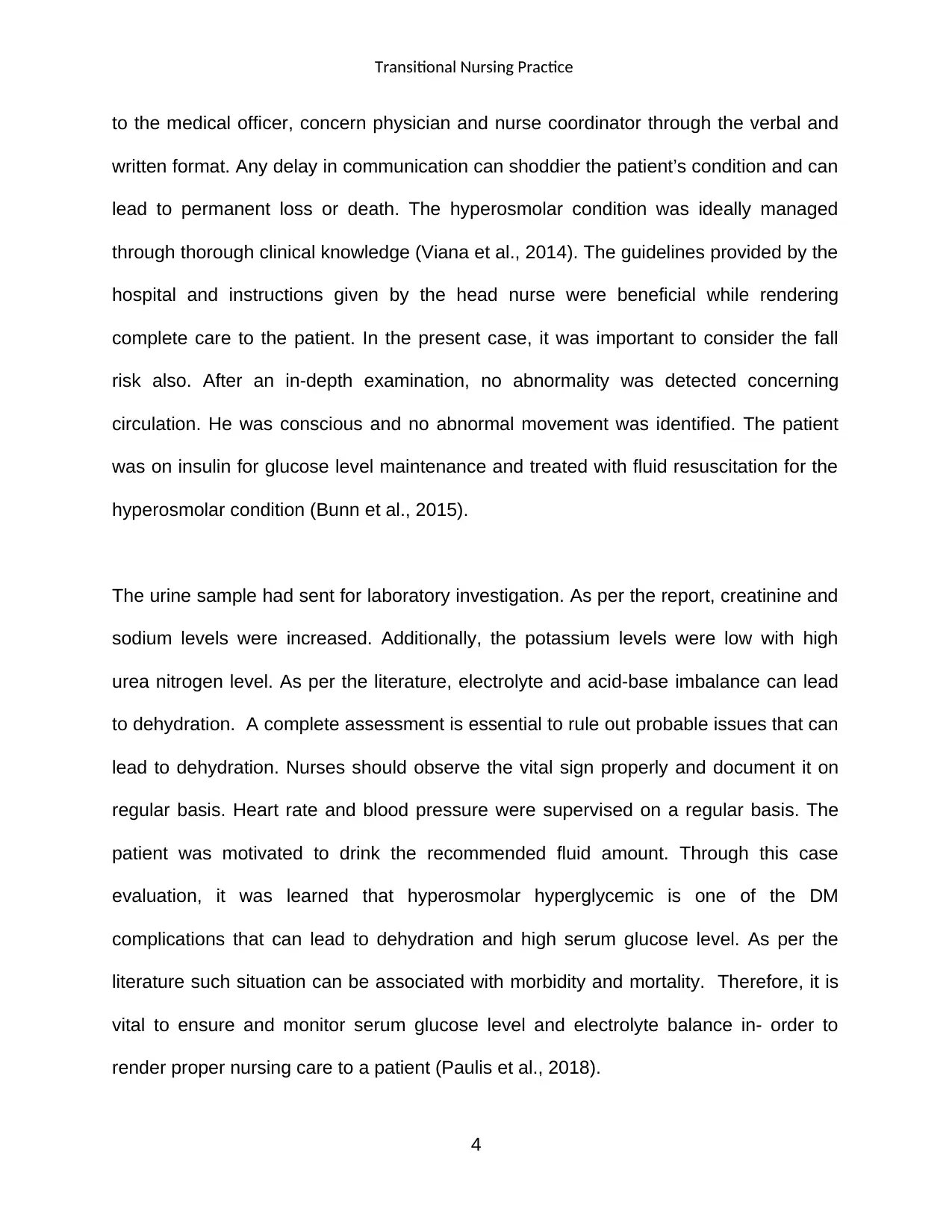
Transitional Nursing Practice
to the medical officer, concern physician and nurse coordinator through the verbal and
written format. Any delay in communication can shoddier the patient’s condition and can
lead to permanent loss or death. The hyperosmolar condition was ideally managed
through thorough clinical knowledge (Viana et al., 2014). The guidelines provided by the
hospital and instructions given by the head nurse were beneficial while rendering
complete care to the patient. In the present case, it was important to consider the fall
risk also. After an in-depth examination, no abnormality was detected concerning
circulation. He was conscious and no abnormal movement was identified. The patient
was on insulin for glucose level maintenance and treated with fluid resuscitation for the
hyperosmolar condition (Bunn et al., 2015).
The urine sample had sent for laboratory investigation. As per the report, creatinine and
sodium levels were increased. Additionally, the potassium levels were low with high
urea nitrogen level. As per the literature, electrolyte and acid-base imbalance can lead
to dehydration. A complete assessment is essential to rule out probable issues that can
lead to dehydration. Nurses should observe the vital sign properly and document it on
regular basis. Heart rate and blood pressure were supervised on a regular basis. The
patient was motivated to drink the recommended fluid amount. Through this case
evaluation, it was learned that hyperosmolar hyperglycemic is one of the DM
complications that can lead to dehydration and high serum glucose level. As per the
literature such situation can be associated with morbidity and mortality. Therefore, it is
vital to ensure and monitor serum glucose level and electrolyte balance in- order to
render proper nursing care to a patient (Paulis et al., 2018).
4
to the medical officer, concern physician and nurse coordinator through the verbal and
written format. Any delay in communication can shoddier the patient’s condition and can
lead to permanent loss or death. The hyperosmolar condition was ideally managed
through thorough clinical knowledge (Viana et al., 2014). The guidelines provided by the
hospital and instructions given by the head nurse were beneficial while rendering
complete care to the patient. In the present case, it was important to consider the fall
risk also. After an in-depth examination, no abnormality was detected concerning
circulation. He was conscious and no abnormal movement was identified. The patient
was on insulin for glucose level maintenance and treated with fluid resuscitation for the
hyperosmolar condition (Bunn et al., 2015).
The urine sample had sent for laboratory investigation. As per the report, creatinine and
sodium levels were increased. Additionally, the potassium levels were low with high
urea nitrogen level. As per the literature, electrolyte and acid-base imbalance can lead
to dehydration. A complete assessment is essential to rule out probable issues that can
lead to dehydration. Nurses should observe the vital sign properly and document it on
regular basis. Heart rate and blood pressure were supervised on a regular basis. The
patient was motivated to drink the recommended fluid amount. Through this case
evaluation, it was learned that hyperosmolar hyperglycemic is one of the DM
complications that can lead to dehydration and high serum glucose level. As per the
literature such situation can be associated with morbidity and mortality. Therefore, it is
vital to ensure and monitor serum glucose level and electrolyte balance in- order to
render proper nursing care to a patient (Paulis et al., 2018).
4
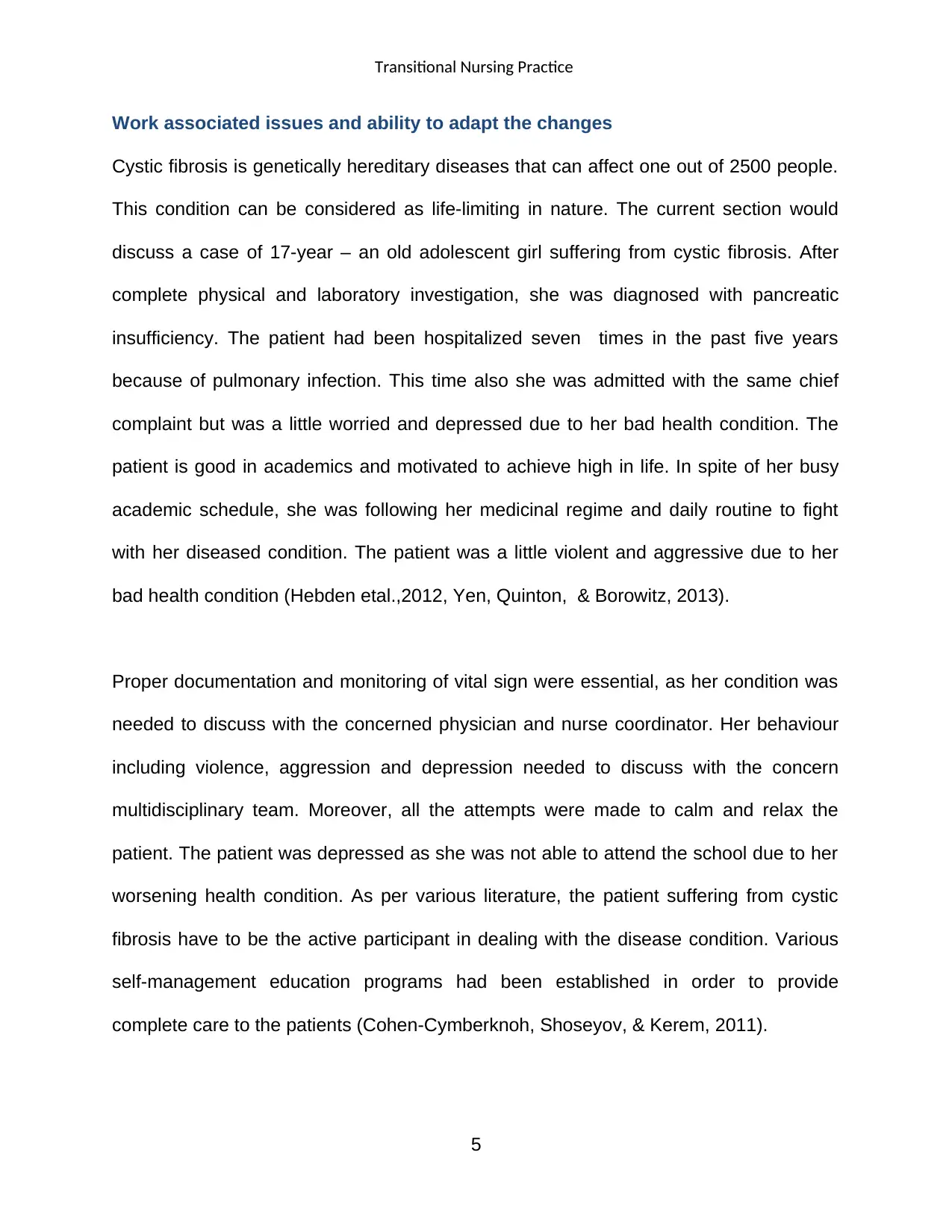
Transitional Nursing Practice
Work associated issues and ability to adapt the changes
Cystic fibrosis is genetically hereditary diseases that can affect one out of 2500 people.
This condition can be considered as life-limiting in nature. The current section would
discuss a case of 17-year – an old adolescent girl suffering from cystic fibrosis. After
complete physical and laboratory investigation, she was diagnosed with pancreatic
insufficiency. The patient had been hospitalized seven times in the past five years
because of pulmonary infection. This time also she was admitted with the same chief
complaint but was a little worried and depressed due to her bad health condition. The
patient is good in academics and motivated to achieve high in life. In spite of her busy
academic schedule, she was following her medicinal regime and daily routine to fight
with her diseased condition. The patient was a little violent and aggressive due to her
bad health condition (Hebden etal.,2012, Yen, Quinton, & Borowitz, 2013).
Proper documentation and monitoring of vital sign were essential, as her condition was
needed to discuss with the concerned physician and nurse coordinator. Her behaviour
including violence, aggression and depression needed to discuss with the concern
multidisciplinary team. Moreover, all the attempts were made to calm and relax the
patient. The patient was depressed as she was not able to attend the school due to her
worsening health condition. As per various literature, the patient suffering from cystic
fibrosis have to be the active participant in dealing with the disease condition. Various
self-management education programs had been established in order to provide
complete care to the patients (Cohen-Cymberknoh, Shoseyov, & Kerem, 2011).
5
Work associated issues and ability to adapt the changes
Cystic fibrosis is genetically hereditary diseases that can affect one out of 2500 people.
This condition can be considered as life-limiting in nature. The current section would
discuss a case of 17-year – an old adolescent girl suffering from cystic fibrosis. After
complete physical and laboratory investigation, she was diagnosed with pancreatic
insufficiency. The patient had been hospitalized seven times in the past five years
because of pulmonary infection. This time also she was admitted with the same chief
complaint but was a little worried and depressed due to her bad health condition. The
patient is good in academics and motivated to achieve high in life. In spite of her busy
academic schedule, she was following her medicinal regime and daily routine to fight
with her diseased condition. The patient was a little violent and aggressive due to her
bad health condition (Hebden etal.,2012, Yen, Quinton, & Borowitz, 2013).
Proper documentation and monitoring of vital sign were essential, as her condition was
needed to discuss with the concerned physician and nurse coordinator. Her behaviour
including violence, aggression and depression needed to discuss with the concern
multidisciplinary team. Moreover, all the attempts were made to calm and relax the
patient. The patient was depressed as she was not able to attend the school due to her
worsening health condition. As per various literature, the patient suffering from cystic
fibrosis have to be the active participant in dealing with the disease condition. Various
self-management education programs had been established in order to provide
complete care to the patients (Cohen-Cymberknoh, Shoseyov, & Kerem, 2011).
5
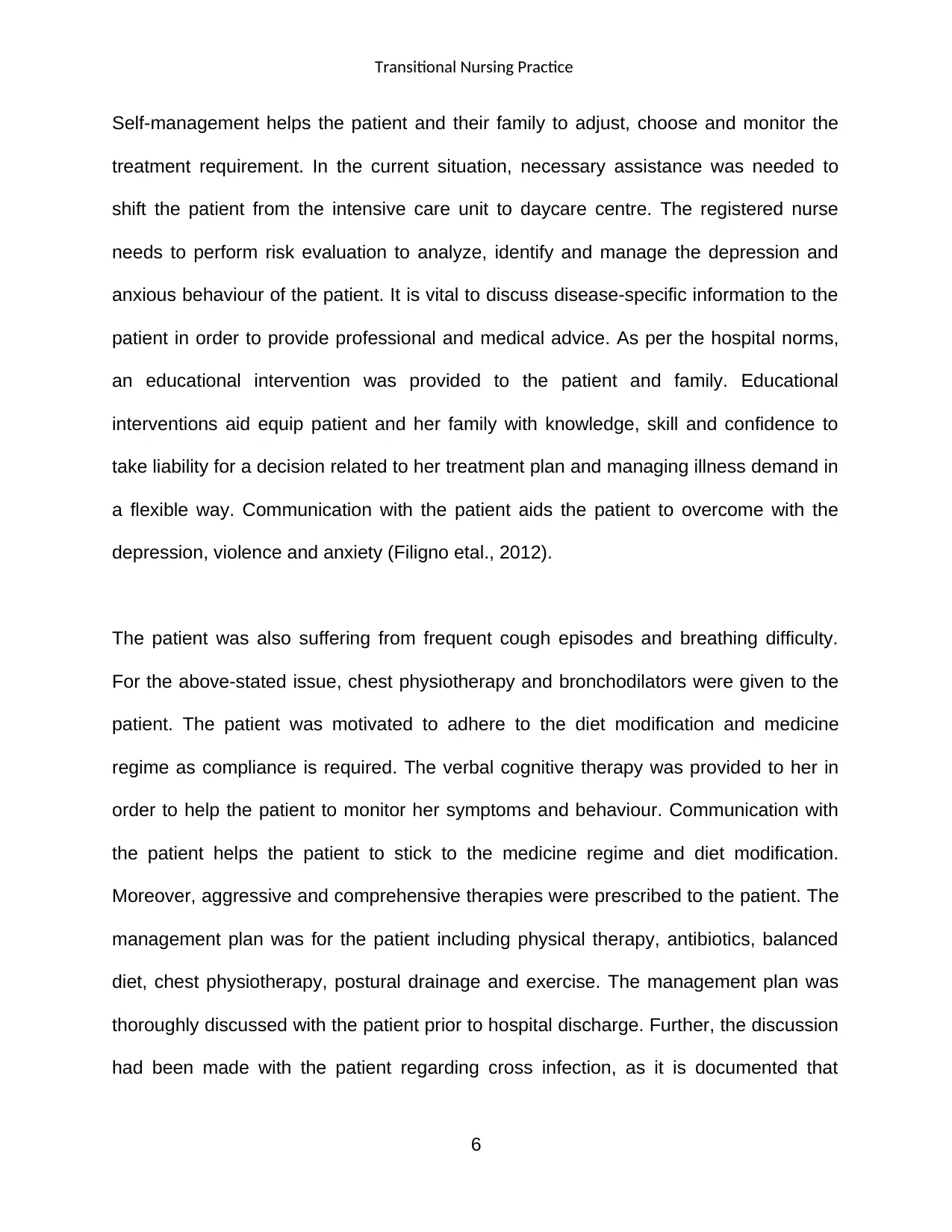
Transitional Nursing Practice
Self-management helps the patient and their family to adjust, choose and monitor the
treatment requirement. In the current situation, necessary assistance was needed to
shift the patient from the intensive care unit to daycare centre. The registered nurse
needs to perform risk evaluation to analyze, identify and manage the depression and
anxious behaviour of the patient. It is vital to discuss disease-specific information to the
patient in order to provide professional and medical advice. As per the hospital norms,
an educational intervention was provided to the patient and family. Educational
interventions aid equip patient and her family with knowledge, skill and confidence to
take liability for a decision related to her treatment plan and managing illness demand in
a flexible way. Communication with the patient aids the patient to overcome with the
depression, violence and anxiety (Filigno etal., 2012).
The patient was also suffering from frequent cough episodes and breathing difficulty.
For the above-stated issue, chest physiotherapy and bronchodilators were given to the
patient. The patient was motivated to adhere to the diet modification and medicine
regime as compliance is required. The verbal cognitive therapy was provided to her in
order to help the patient to monitor her symptoms and behaviour. Communication with
the patient helps the patient to stick to the medicine regime and diet modification.
Moreover, aggressive and comprehensive therapies were prescribed to the patient. The
management plan was for the patient including physical therapy, antibiotics, balanced
diet, chest physiotherapy, postural drainage and exercise. The management plan was
thoroughly discussed with the patient prior to hospital discharge. Further, the discussion
had been made with the patient regarding cross infection, as it is documented that
6
Self-management helps the patient and their family to adjust, choose and monitor the
treatment requirement. In the current situation, necessary assistance was needed to
shift the patient from the intensive care unit to daycare centre. The registered nurse
needs to perform risk evaluation to analyze, identify and manage the depression and
anxious behaviour of the patient. It is vital to discuss disease-specific information to the
patient in order to provide professional and medical advice. As per the hospital norms,
an educational intervention was provided to the patient and family. Educational
interventions aid equip patient and her family with knowledge, skill and confidence to
take liability for a decision related to her treatment plan and managing illness demand in
a flexible way. Communication with the patient aids the patient to overcome with the
depression, violence and anxiety (Filigno etal., 2012).
The patient was also suffering from frequent cough episodes and breathing difficulty.
For the above-stated issue, chest physiotherapy and bronchodilators were given to the
patient. The patient was motivated to adhere to the diet modification and medicine
regime as compliance is required. The verbal cognitive therapy was provided to her in
order to help the patient to monitor her symptoms and behaviour. Communication with
the patient helps the patient to stick to the medicine regime and diet modification.
Moreover, aggressive and comprehensive therapies were prescribed to the patient. The
management plan was for the patient including physical therapy, antibiotics, balanced
diet, chest physiotherapy, postural drainage and exercise. The management plan was
thoroughly discussed with the patient prior to hospital discharge. Further, the discussion
had been made with the patient regarding cross infection, as it is documented that
6
Paraphrase This Document
Need a fresh take? Get an instant paraphrase of this document with our AI Paraphraser
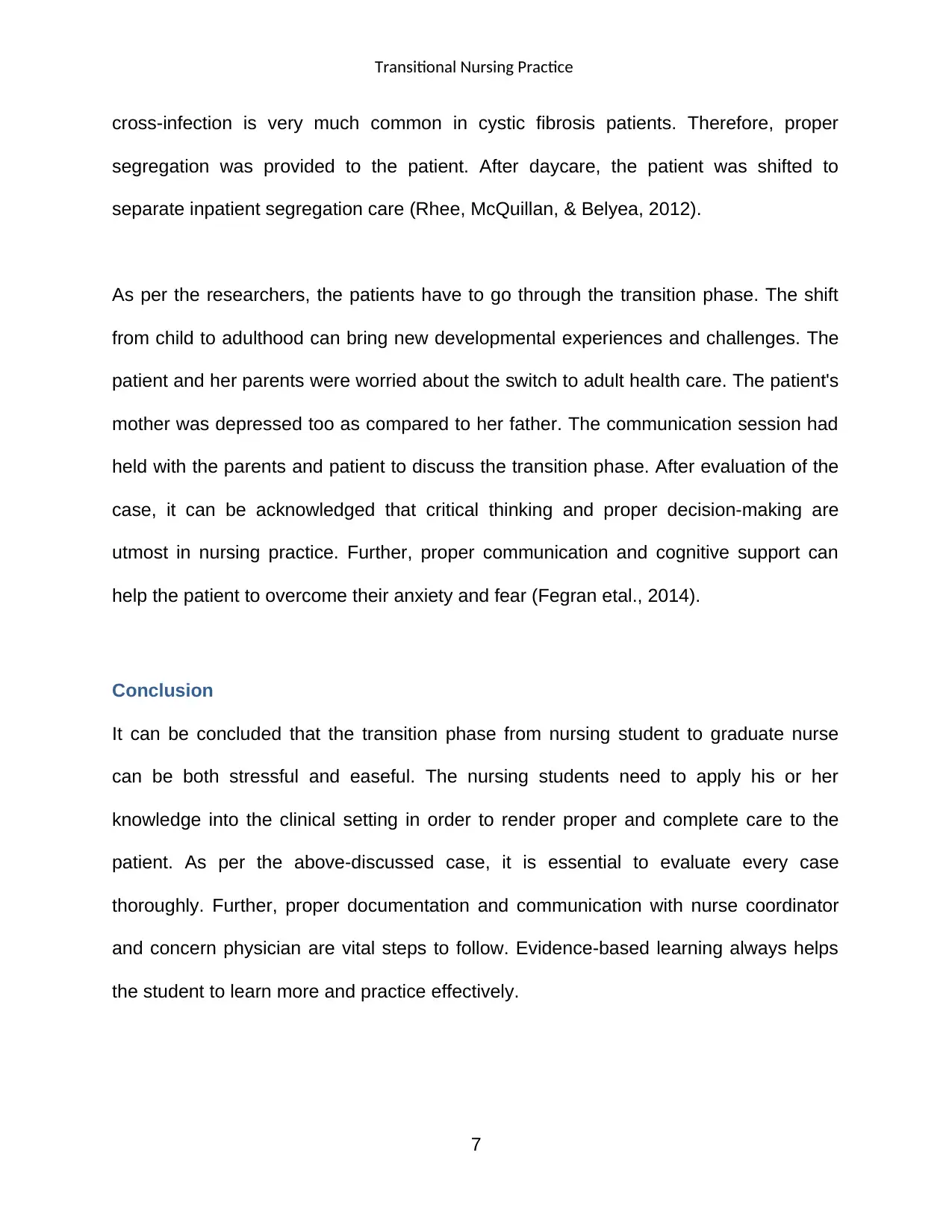
Transitional Nursing Practice
cross-infection is very much common in cystic fibrosis patients. Therefore, proper
segregation was provided to the patient. After daycare, the patient was shifted to
separate inpatient segregation care (Rhee, McQuillan, & Belyea, 2012).
As per the researchers, the patients have to go through the transition phase. The shift
from child to adulthood can bring new developmental experiences and challenges. The
patient and her parents were worried about the switch to adult health care. The patient's
mother was depressed too as compared to her father. The communication session had
held with the parents and patient to discuss the transition phase. After evaluation of the
case, it can be acknowledged that critical thinking and proper decision-making are
utmost in nursing practice. Further, proper communication and cognitive support can
help the patient to overcome their anxiety and fear (Fegran etal., 2014).
Conclusion
It can be concluded that the transition phase from nursing student to graduate nurse
can be both stressful and easeful. The nursing students need to apply his or her
knowledge into the clinical setting in order to render proper and complete care to the
patient. As per the above-discussed case, it is essential to evaluate every case
thoroughly. Further, proper documentation and communication with nurse coordinator
and concern physician are vital steps to follow. Evidence-based learning always helps
the student to learn more and practice effectively.
7
cross-infection is very much common in cystic fibrosis patients. Therefore, proper
segregation was provided to the patient. After daycare, the patient was shifted to
separate inpatient segregation care (Rhee, McQuillan, & Belyea, 2012).
As per the researchers, the patients have to go through the transition phase. The shift
from child to adulthood can bring new developmental experiences and challenges. The
patient and her parents were worried about the switch to adult health care. The patient's
mother was depressed too as compared to her father. The communication session had
held with the parents and patient to discuss the transition phase. After evaluation of the
case, it can be acknowledged that critical thinking and proper decision-making are
utmost in nursing practice. Further, proper communication and cognitive support can
help the patient to overcome their anxiety and fear (Fegran etal., 2014).
Conclusion
It can be concluded that the transition phase from nursing student to graduate nurse
can be both stressful and easeful. The nursing students need to apply his or her
knowledge into the clinical setting in order to render proper and complete care to the
patient. As per the above-discussed case, it is essential to evaluate every case
thoroughly. Further, proper documentation and communication with nurse coordinator
and concern physician are vital steps to follow. Evidence-based learning always helps
the student to learn more and practice effectively.
7
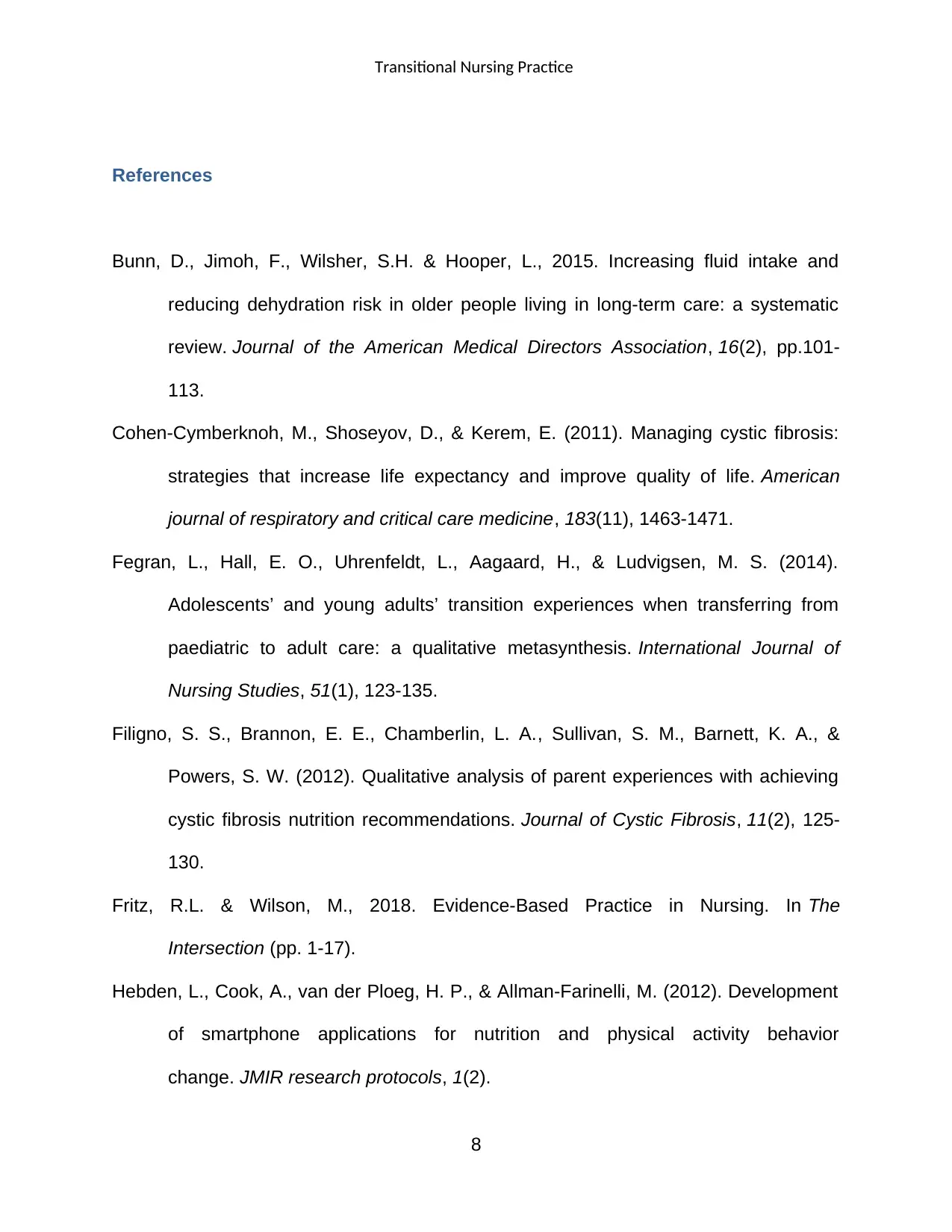
Transitional Nursing Practice
References
Bunn, D., Jimoh, F., Wilsher, S.H. & Hooper, L., 2015. Increasing fluid intake and
reducing dehydration risk in older people living in long-term care: a systematic
review. Journal of the American Medical Directors Association, 16(2), pp.101-
113.
Cohen-Cymberknoh, M., Shoseyov, D., & Kerem, E. (2011). Managing cystic fibrosis:
strategies that increase life expectancy and improve quality of life. American
journal of respiratory and critical care medicine, 183(11), 1463-1471.
Fegran, L., Hall, E. O., Uhrenfeldt, L., Aagaard, H., & Ludvigsen, M. S. (2014).
Adolescents’ and young adults’ transition experiences when transferring from
paediatric to adult care: a qualitative metasynthesis. International Journal of
Nursing Studies, 51(1), 123-135.
Filigno, S. S., Brannon, E. E., Chamberlin, L. A., Sullivan, S. M., Barnett, K. A., &
Powers, S. W. (2012). Qualitative analysis of parent experiences with achieving
cystic fibrosis nutrition recommendations. Journal of Cystic Fibrosis, 11(2), 125-
130.
Fritz, R.L. & Wilson, M., 2018. Evidence-Based Practice in Nursing. In The
Intersection (pp. 1-17).
Hebden, L., Cook, A., van der Ploeg, H. P., & Allman-Farinelli, M. (2012). Development
of smartphone applications for nutrition and physical activity behavior
change. JMIR research protocols, 1(2).
8
References
Bunn, D., Jimoh, F., Wilsher, S.H. & Hooper, L., 2015. Increasing fluid intake and
reducing dehydration risk in older people living in long-term care: a systematic
review. Journal of the American Medical Directors Association, 16(2), pp.101-
113.
Cohen-Cymberknoh, M., Shoseyov, D., & Kerem, E. (2011). Managing cystic fibrosis:
strategies that increase life expectancy and improve quality of life. American
journal of respiratory and critical care medicine, 183(11), 1463-1471.
Fegran, L., Hall, E. O., Uhrenfeldt, L., Aagaard, H., & Ludvigsen, M. S. (2014).
Adolescents’ and young adults’ transition experiences when transferring from
paediatric to adult care: a qualitative metasynthesis. International Journal of
Nursing Studies, 51(1), 123-135.
Filigno, S. S., Brannon, E. E., Chamberlin, L. A., Sullivan, S. M., Barnett, K. A., &
Powers, S. W. (2012). Qualitative analysis of parent experiences with achieving
cystic fibrosis nutrition recommendations. Journal of Cystic Fibrosis, 11(2), 125-
130.
Fritz, R.L. & Wilson, M., 2018. Evidence-Based Practice in Nursing. In The
Intersection (pp. 1-17).
Hebden, L., Cook, A., van der Ploeg, H. P., & Allman-Farinelli, M. (2012). Development
of smartphone applications for nutrition and physical activity behavior
change. JMIR research protocols, 1(2).
8
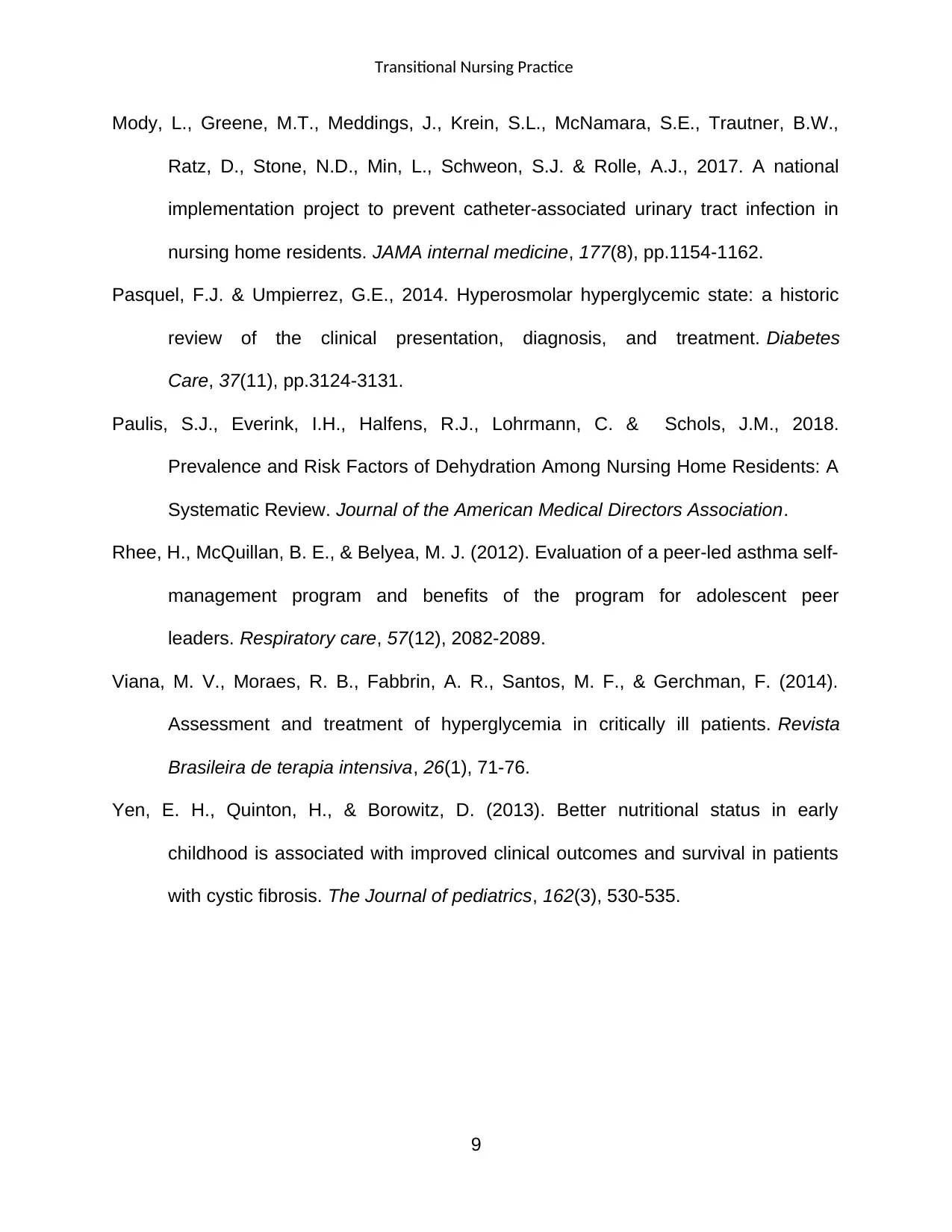
Transitional Nursing Practice
Mody, L., Greene, M.T., Meddings, J., Krein, S.L., McNamara, S.E., Trautner, B.W.,
Ratz, D., Stone, N.D., Min, L., Schweon, S.J. & Rolle, A.J., 2017. A national
implementation project to prevent catheter-associated urinary tract infection in
nursing home residents. JAMA internal medicine, 177(8), pp.1154-1162.
Pasquel, F.J. & Umpierrez, G.E., 2014. Hyperosmolar hyperglycemic state: a historic
review of the clinical presentation, diagnosis, and treatment. Diabetes
Care, 37(11), pp.3124-3131.
Paulis, S.J., Everink, I.H., Halfens, R.J., Lohrmann, C. & Schols, J.M., 2018.
Prevalence and Risk Factors of Dehydration Among Nursing Home Residents: A
Systematic Review. Journal of the American Medical Directors Association.
Rhee, H., McQuillan, B. E., & Belyea, M. J. (2012). Evaluation of a peer-led asthma self-
management program and benefits of the program for adolescent peer
leaders. Respiratory care, 57(12), 2082-2089.
Viana, M. V., Moraes, R. B., Fabbrin, A. R., Santos, M. F., & Gerchman, F. (2014).
Assessment and treatment of hyperglycemia in critically ill patients. Revista
Brasileira de terapia intensiva, 26(1), 71-76.
Yen, E. H., Quinton, H., & Borowitz, D. (2013). Better nutritional status in early
childhood is associated with improved clinical outcomes and survival in patients
with cystic fibrosis. The Journal of pediatrics, 162(3), 530-535.
9
Mody, L., Greene, M.T., Meddings, J., Krein, S.L., McNamara, S.E., Trautner, B.W.,
Ratz, D., Stone, N.D., Min, L., Schweon, S.J. & Rolle, A.J., 2017. A national
implementation project to prevent catheter-associated urinary tract infection in
nursing home residents. JAMA internal medicine, 177(8), pp.1154-1162.
Pasquel, F.J. & Umpierrez, G.E., 2014. Hyperosmolar hyperglycemic state: a historic
review of the clinical presentation, diagnosis, and treatment. Diabetes
Care, 37(11), pp.3124-3131.
Paulis, S.J., Everink, I.H., Halfens, R.J., Lohrmann, C. & Schols, J.M., 2018.
Prevalence and Risk Factors of Dehydration Among Nursing Home Residents: A
Systematic Review. Journal of the American Medical Directors Association.
Rhee, H., McQuillan, B. E., & Belyea, M. J. (2012). Evaluation of a peer-led asthma self-
management program and benefits of the program for adolescent peer
leaders. Respiratory care, 57(12), 2082-2089.
Viana, M. V., Moraes, R. B., Fabbrin, A. R., Santos, M. F., & Gerchman, F. (2014).
Assessment and treatment of hyperglycemia in critically ill patients. Revista
Brasileira de terapia intensiva, 26(1), 71-76.
Yen, E. H., Quinton, H., & Borowitz, D. (2013). Better nutritional status in early
childhood is associated with improved clinical outcomes and survival in patients
with cystic fibrosis. The Journal of pediatrics, 162(3), 530-535.
9
1 out of 10
Related Documents
Your All-in-One AI-Powered Toolkit for Academic Success.
+13062052269
info@desklib.com
Available 24*7 on WhatsApp / Email
![[object Object]](/_next/static/media/star-bottom.7253800d.svg)
Unlock your academic potential
© 2024 | Zucol Services PVT LTD | All rights reserved.





